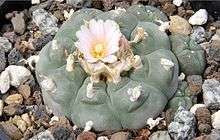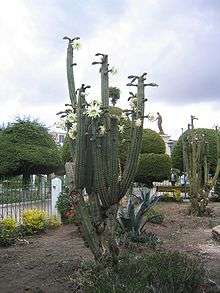Psychoactive cactus
Many cacti are known to be psychoactive, containing phenethylamine alkaloids such as mescaline[1] However, the two main ritualistic (folkloric) genera are Echinopsis, of which the most psychoactive species is the San Pedro cactus (Echinopsis pachanoi, syn. Trichocereus pachanoi), and Lophophora, with peyote (Lophophora williamsii) being the most psychoactive species. Several other species pertaining to other genera are also psychoactive, though not always used with a ritualistic intent.[2][3][4]
Ethnic Use
Several world regions have historically used psychoactive cacti for their properties, particularly Indigenous peoples from Central and South America, such as in Mexico and the Andes region. For this purpose (which includes commercial harvesting) cacti plants are specifically grown in the millions.[5] Lophophora williamsii (peyote) is used by the Native American Church (aka Peyotism).
Species
"Peyotes"
- Lophophora williamsii (peyote)

Other "peyotes"
- Ariocarpus fissuratus
- Coryphantha compacta
- Pelecyphora aselliformis; strobiliformis
- Lophophora diffusa
- Ariocarpus retusus
- Ariocarpus agavoides; kotschoubeyanus; and other species
- Astrophytum asterias; capricorne; myriostigma; and other species
- Aztekium ritteri; and other species
- Coryphantha elephantidens; macromeris (var. runyonii); palmeri; and other species
- Echinocactus grandis; grusonii; platyacanthus; visnaga; and other species
- Epithelantha micromeris; and other species
- Leuchtenbergia principis'; and other species
- Lophophora species
- Mammillaria craigii; grahamii (var. oliviae); heyderi; (Dolichothele) longimamma; (Solisia) pectinifera; (Mamillopsis) senilis; sonorensis; and other species
- Obregonia denegrii
- Strombocactus disciformis
- Turbinicarpus laui; lophophoroides; jauernigii; pseudomacrochele; (Pelecyphora) pseudopectinatus; schmiedickeanus; and other species
Other North American psychoactive and/or medicinal cacti-
- Carnegiea gigantea
- Echinocereus salm-dyckianus (var. scheeri); triglochidiatus; and other species
- Pachycereus pecten-aboriginum; pringlei
Trichocereus
- Echinopsis lageniformis (syn. Trichocereus bridgesii) (Bolivian torch cactus)
- Echinopsis pachanoi (syn. Trichocereus pachanoi) (San Pedro cactus)
- Echinopsis peruviana (syn. Trichocereus peruvianus) (Peruvian torch cactus)

Other South American psychoactive and/or medicinal cacti
- Armatocereus laetus
- Browningia spp.
- Epostoa lanata
- Matucana madisoniorum
- Neoraimondia macrostibas
- Trichocereus terscheckii
- Stetsonia coryne
Legality
See also
References/Sources
- Bruhn, Jan G.; Hesham R. EI-Seedi; Nikolai Stephanson (2008). "Ecstasy Analogues Found in Cacti". Journal of Psychoactive Drugs. 40 (2): 219–222. CiteSeerX 10.1.1.689.4014. doi:10.1080/02791072.2008.10400635. PMID 18720674.
- Bruhn, Jan G. (1973). "Ethnobotanical Search for Hallucinogenic Cacti1". Planta Med. 24 (8): 315–319. doi:10.1055/s-0028-1099504. PMID 4789553.
- Bruhn, Jan G.; Catarina Bruhn (1973). "Alkaloids and ethnobotany of Mexican peyote cacti and related species". Economic Botany. 27 (2): 241–251. doi:10.1007/BF02872994.
- Pummangura, S.; J. L. McLaughlin; R. C. Schifferdecker (September 1981). "Cactus Alkaloids. XLVII. β-Phenethylamines From the "Missouri Pincushion", Coryphantha (Neobessya) missouriensis". J. Nat. Prod. 44 (5): 614–616. doi:10.1021/np50017a022.
- Gottlieb, Adam (1997). Peyote and Other Psychoactive Cacti. Ronin Publishing. p. 96.
External links

- www.cactus-mall.com